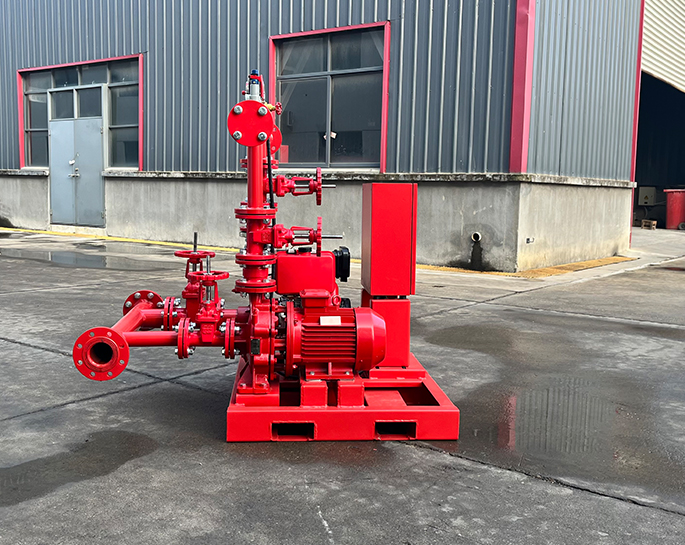What role do pressure relief valves play in fire pump systems?
Aug 07, 2024
Share:
Pressure relief valves (PRVs) are crucial components in fire pump systems. Their primary role is to protect the system from excessive pressure, which can cause damage to pipes, fittings, and other components. Here’s a detailed look at their functions and importance:
### Functions of Pressure Relief Valves in Fire Pump Systems:
1. **Pressure Regulation**:
- PRVs help maintain a consistent pressure within the system, preventing pressure surges that can occur when a pump starts or stops suddenly.
2. **System Protection**:
- They protect the fire pump and associated piping from overpressure conditions that could lead to mechanical failure or burst pipes.
3. **Safety Assurance**:
- By preventing overpressure, PRVs ensure the safety of personnel working with or near the fire pump system.
4. **Compliance with Standards**:
- Fire pump systems are often required by codes and standards (e.g., NFPA 20) to have pressure relief valves to ensure safe operation.
### How PRVs Work:
- **Set Pressure**:
- PRVs are set to open at a predetermined pressure level. When the system pressure exceeds this set point, the valve opens to release excess pressure.
- **Relief Path**:
- Once the valve opens, the excess pressure is typically diverted to a safe discharge location, such as a drain or back to the water supply.
- **Automatic Operation**:
- PRVs operate automatically, requiring no manual intervention to open and close as needed.
### Types of Pressure Relief Valves:
1. **Spring-Loaded PRVs**:
- These valves use a spring mechanism to open and close the valve based on pressure changes.
2. **Pilot-Operated PRVs**:
- These are more complex and use a pilot valve to control the main relief valve, allowing for more precise pressure control.
### Installation Considerations:
- **Location**:
- PRVs should be installed at strategic points within the fire pump system, typically near the pump discharge side, to effectively manage pressure.
- **Sizing**:
- Proper sizing of the PRV is critical to ensure it can handle the maximum expected pressure and flow rate.
- **Maintenance**:
- Regular maintenance and testing are essential to ensure PRVs function correctly when needed.
In summary, pressure relief valves are vital for the safe and efficient operation of fire pump systems, ensuring protection from overpressure and compliance with safety standards.

### Functions of Pressure Relief Valves in Fire Pump Systems:
1. **Pressure Regulation**:
- PRVs help maintain a consistent pressure within the system, preventing pressure surges that can occur when a pump starts or stops suddenly.
2. **System Protection**:
- They protect the fire pump and associated piping from overpressure conditions that could lead to mechanical failure or burst pipes.
3. **Safety Assurance**:
- By preventing overpressure, PRVs ensure the safety of personnel working with or near the fire pump system.
4. **Compliance with Standards**:
- Fire pump systems are often required by codes and standards (e.g., NFPA 20) to have pressure relief valves to ensure safe operation.
### How PRVs Work:
- **Set Pressure**:
- PRVs are set to open at a predetermined pressure level. When the system pressure exceeds this set point, the valve opens to release excess pressure.
- **Relief Path**:
- Once the valve opens, the excess pressure is typically diverted to a safe discharge location, such as a drain or back to the water supply.
- **Automatic Operation**:
- PRVs operate automatically, requiring no manual intervention to open and close as needed.
### Types of Pressure Relief Valves:
1. **Spring-Loaded PRVs**:
- These valves use a spring mechanism to open and close the valve based on pressure changes.
2. **Pilot-Operated PRVs**:
- These are more complex and use a pilot valve to control the main relief valve, allowing for more precise pressure control.
### Installation Considerations:
- **Location**:
- PRVs should be installed at strategic points within the fire pump system, typically near the pump discharge side, to effectively manage pressure.
- **Sizing**:
- Proper sizing of the PRV is critical to ensure it can handle the maximum expected pressure and flow rate.
- **Maintenance**:
- Regular maintenance and testing are essential to ensure PRVs function correctly when needed.
In summary, pressure relief valves are vital for the safe and efficient operation of fire pump systems, ensuring protection from overpressure and compliance with safety standards.


.png)
.png)

.png)


